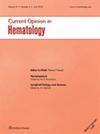Tissue factor pathway inhibitor - cofactor-dependent regulation of the initiation of coagulation.
IF 2.9
3区 医学
Q2 HEMATOLOGY
引用次数: 0
Abstract
PURPOSE OF REVIEW In humans, tissue factor pathway inhibitor (TFPI) exists in two alternatively spliced isoforms, TFPIα and TFPIβ. TFPIα consists of three Kunitz domains (K1, K2 and K3) and a highly basic C-terminal tail. K1 inhibits the tissue factor-activated factor VII complex, K2 specifically inhibits activated factor X, K3 is essential for interaction with its cofactor, protein S, and the basic C-terminus is binds factor V-short (FV-short) with high affinity. TFPIβ consists of K1 and K2 that is glycosylphosphatidylinositol anchored directly to cell surfaces. This review explores the structure/function of TFPI and its cofactors (protein S and FV-short), and the relative contributions that different TFPI isoforms may play in haemostatic control. RECENT FINDINGS Recent data have underscored the importance of TFPIα function and its reliance on its cofactors, protein S and FV-short, in influencing haemostatic control as well as bleeding and thrombotic risk. SUMMARY TFPIα is likely the most important pool of TFPI in modifying the risk of thrombosis and bleeding. TFPIα forms a trimolecular complex with FV-short and protein S in plasma. FV-short expression levels control the circulating levels of TFPIα, whereas protein S exerts essential cofactor mediated augmentation of it anticoagulant function.组织因子通路抑制剂--依赖于辅因子的凝血启动调控。
综述目的 在人体中,组织因子通路抑制因子(TFPI)存在两种交替剪接的异构体,即 TFPIα 和 TFPIβ。TFPIα 由三个 Kunitz 结构域(K1、K2 和 K3)和一个高度碱性的 C 端尾部组成。K1 可抑制组织因子-活化因子 VII 复合物,K2 可特异性抑制活化因子 X,K3 对与其辅助因子蛋白 S 的相互作用至关重要,而基本的 C 端则能以高亲和力结合因子 V-短(FV-短)。TFPIβ 由 K1 和 K2 组成,糖基磷脂酰肌醇直接锚定在细胞表面。本综述探讨了 TFPI 及其辅助因子(蛋白 S 和 FV-短)的结构/功能,以及不同 TFPI 异构体在止血控制中可能发挥的相对作用。最近的发现最近的数据强调了 TFPIα 功能的重要性,以及它对辅助因子(蛋白 S 和 FV-短链)的依赖在影响止血控制以及出血和血栓风险方面的重要性。TFPIα 在血浆中与 FV 短链和蛋白 S 形成三分子复合物。FV-short 的表达水平控制着 TFPIα 的循环水平,而蛋白 S 则发挥着重要的辅助因子介导的增强抗凝功能的作用。
本文章由计算机程序翻译,如有差异,请以英文原文为准。
求助全文
约1分钟内获得全文
求助全文
来源期刊
CiteScore
6.60
自引率
3.10%
发文量
78
审稿时长
6-12 weeks
期刊介绍:
Current Opinion in Hematology is an easy-to-digest bimonthly journal covering the most interesting and important advances in the field of hematology. Its hand-picked selection of editors ensure the highest quality selection of unbiased review articles on themes from nine key subject areas, including myeloid biology, Vascular biology, hematopoiesis and erythroid system and its diseases.

 求助内容:
求助内容: 应助结果提醒方式:
应助结果提醒方式:


